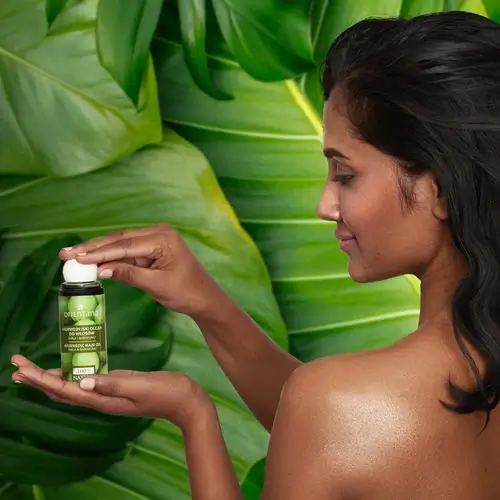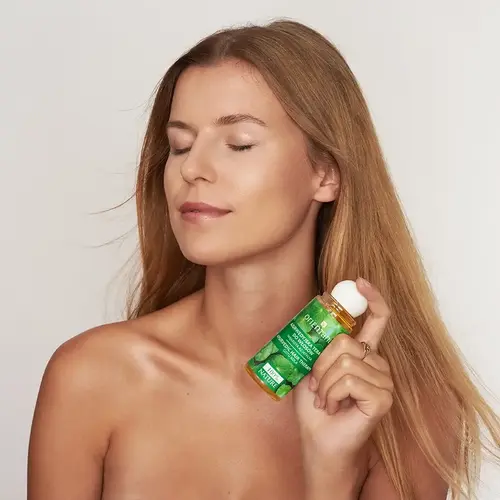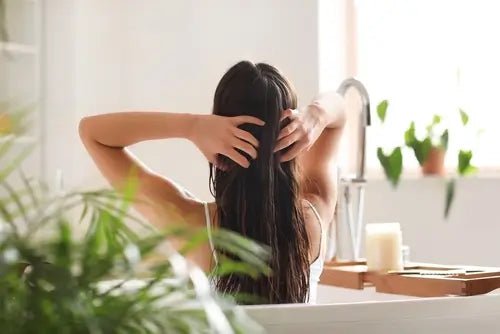Oiling hair is one of the oldest hair care rituals in India, used for thousands of years. It comes from Ayurveda – ancient Indian medicine, according to which healthy hair is a reflection of the overall condition of the body. Oiling is not only a way to beautiful, shiny hair, but also to relax, improve well-being and maintain harmony of body and mind. In India, this practice is passed down from generation to generation – mothers teach their daughters how to care for their hair from an early age.
Some historical sources indicate that the tradition of oiling hair dates back as far as 5,000 years . Ancient Ayurvedic texts such as the Charaka Samhita mention the use of vegetable oils to strengthen hair and improve its condition. Women of higher castes used precious oils such as sandalwood or jasmine oil to not only condition their hair but also to give it a beautiful scent. It was believed that the right oils could attract positive energy and increase life force.

Hair Oiling in India - History and Importance
Oiling hair has always been considered more than just a cosmetic treatment – it has been treated as a care ritual that helps maintain hair health, but also emotional and spiritual balance . In India, it is believed that a head massage with oil calms the mind, reduces stress and helps with better sleep .
In the past, young girls were required to oil their hair at least three times a week , and on holidays, older women helped them with this ritual. It was a time of building family bonds – older generations passed on knowledge about hair care and choosing the right oils to younger ones. Hair oiling usually took place in the evening, by candlelight and aromatic incense, which created an extremely relaxing atmosphere.
Interestingly, you can still meet women with incredibly long, shiny hair who oil it regularly from childhood. In some regions of India, it is still believed that a woman with beautiful, healthy hair is a symbol of prosperity and happiness in the family.
Benefits of oiling your hair

Oiling your hair brings many benefits to both your scalp and your hair. First of all, it deeply moisturizes and nourishes your scalp, which prevents it from drying out and problems like dandruff or itching. Regular use of oils strengthens hair follicles, which reduces hair loss and accelerates growth. It is worth mentioning that some oils, such as amla oil, are rich in antioxidants and vitamin C, which prevent premature graying and loss of color.
Oiling creates a protective layer on the hair that protects it from harmful external factors, such as strong UV radiation, pollution or frequent styling . Women in India who use oiling throughout their lives often have thick, healthy hair even in old age. It is not without reason that it is said that the secret of their thick hair lies in the regular use of natural oils. To this day, when Indian women leave home with their children and the sun is beating down, they smooth their children's hair with coconut oil for protection.
Additionally, massaging the scalp with oil improves blood circulation , which affects better oxygenation of the hair follicles and stimulates hair growth. In India, there is even a special head massage technique called "Champi" , which involves vigorously rubbing oil into the scalp. It is from this word that the English term "shampoo" comes from, meaning shampoo!

What oils to use for oiling hair?
Here is a detailed description of the effects of individual oils on hair, based on scientific research:
Coconut oil ( Cocos Nucifera Oil )
Studies have shown that coconut oil has an exceptional ability to penetrate hair, which is due to its low molecular weight structure and high lauric acid content. According to research published in the Journal of Cosmetic Science , coconut oil reduces protein loss in both healthy and damaged hair, protecting it from breakage and mechanical damage.
Sesame oil ( Sesamum Indicum Seed Oil )
Rich in antioxidants, especially sesamin and vitamin E, sesame oil has been shown to protect against UV radiation. Studies conducted by the International Journal of Trichology confirm its ability to absorb ultraviolet radiation, making it an effective natural sunscreen for hair.
Cardamom seed oil ( Elettaria Cardamomum Seed Oil )
Research published in Phytotherapy Research indicates that cardamom oil has antibacterial and antifungal properties, which can prevent scalp infections and eliminate dandruff. In addition, its stimulating effect improves microcirculation in the scalp, which promotes hair growth.
Wheat Germ Oil ( Triticum Vulgare Germ Oil )
Known for its richness in vitamin E and fatty acids, wheat germ oil effectively regenerates hair structure. Studies published in the Journal of Dermatological Science confirm that this oil increases hair moisture and elasticity, reducing brittleness and dryness.
Lemon peel oil ( Citrus Medica Vulgaris Peel Oil )
This oil has a sebum-regulating effect, making it an effective ingredient in the care of oily hair. Studies in the International Journal of Cosmetic Science have shown that lemon oil has antiseptic properties, which helps treat inflammation of the scalp and eliminate dandruff.
Camphor oil ( Cinnamomum Camphora Bark Oil )
Evidence-Based Complementary and Alternative Medicine studies have confirmed that camphor oil improves blood circulation in the scalp, which translates into better oxygenation of hair follicles and stimulation of their growth. It also has anti-inflammatory and antibacterial effects.
Jatamansi oil ( Nardostachys Jatamansi Oil )
Jatamansi has long been used in Ayurveda as an anti-hair loss remedy. Research published in the Journal of Ethnopharmacology has shown that the oil stimulates the anagen (growth) phase of hair, leading to increased hair density and strength.
Pongamia Glabra Seed Oil
Due to its high flavonoid content and antiseptic properties, this oil is effective in treating scalp infections. Research conducted by the Indian Journal of Dermatology indicates that pongamia extracts can reduce skin inflammation and reduce excessive hair loss caused by bacterial infections.
Calamus Root Oil ( Acorus Calamus Root Oil )
Studies in the Journal of Essential Oil Research have shown that calamus oil has strong antioxidant properties, which protect hair from oxidative stress and free radicals. Additionally, it supports the regeneration of the scalp and has anti-dandruff effects.
In summary, each of these oils has been scientifically proven to support hair health, from strengthening and moisturizing to protecting against environmental damage. Regular use can significantly improve the condition of your hair and scalp.
How to properly oil your hair?
Proper hair oiling requires several steps that increase the effectiveness of this ritual. First of all, you need to choose the right oil for your hair type. Coconut oil will work well for low porosity hair, while oils such as amla or bhringraj will be ideal for high porosity hair.
The best effect is achieved when we slightly warm the oil so that it penetrates the scalp better. Then we massage it in circular motions for a few minutes, and then spread it over the entire length of the hair. In India, women often leave the oil overnight so that the hair can take full advantage of its properties. After oiling, we wash the hair with a gentle shampoo (sometimes it is necessary to wash it twice).
Regularity is key – it’s best to oil your hair once or twice a week . This will make it stronger, shinier and healthier.
Oiling hair is an ancient ritual that is still the basis of care in India. It is not only a way to have healthy and beautiful hair, but also to relax and unwind. No wonder that India has been famous for women with incredibly shiny and long hair for centuries. If you dream of strong, healthy and damage-resistant hair - it is worth including oiling in your care routine! 🌿✨
Other methods of oiling hair
Oiling hair can be done using several different methods. One of the most popular techniques is dry hair oiling. Simply spread a little oil on dry hair and rub it in your hands beforehand. It is easier to spread small amounts of oil on your hair and then rub the oil into the hair strands so that the oiling is thorough. This is also the fastest method of oiling hair, but you must remember that the residue of the oil is very difficult to remove from your hair.
The second method of oiling hair involves oiling hair with a mist. To do this, simply mix oil with water and add aloe or glycerin to the mixture. This method is good because you can much more easily control the amount of oil distributed on the hair. This method is quite time-consuming and less durable than traditional dry oiling.
The third method of oiling is wet hair oiling. Simply apply oil to washed hair, then drain excess oil with a T-shirt or paper towel. There is also a two-step method of hair oiling, which is more labor-intensive. This technique involves using one of the above methods, then washing the hair with conditioner, washing the oil and conditioner from the hair, and finally washing the hair with a very gentle shampoo (especially the hair at the roots).
What cosmetics should you choose for oiling your hair?
Proper preparation for hair oiling will be facilitated by carefully selected natural cosmetics. If your hair has been weakened and often falls out, then oiling will help you take care of better hair condition. It is also worth using the power of carefully selected plant extracts, herbs and oils in daily care.
Avoid synthetic ingredients for hair oiling. For example, Moroccanoil Treatment contains argan oil combined with silicones. Beaver Professional offers hair oils, such as the 24K variant with added argan oil, which contain synthetic ingredients that support hair care and styling. Hipertin : Their product Mineral Oil (Diamond Extract) - Hipertin 100ml contains mineral oil, which moisturizes and intensively shines the hair. Initialiste Kerastase Serum contains mineral oil.
No to mineral oil
Mineral oil is the name given to a variety of liquid mixtures created as a byproduct of crude oil distillation. It is a highly purified substance used in cosmetics. Unlike crude oil, mineral oil undergoes refining processes that remove any impurities and potentially harmful ingredients.
The process of obtaining it includes:
Distillation of crude oil , in which various fractions are separated, including gasoline, kerosene, and heavier oils.
Refining and purification that eliminate sulfur compounds and polycyclic aromatic hydrocarbons (PAHs).
Filtration and stabilization , which ensure that the oil meets quality standards (especially in the pharmaceutical and cosmetics industries).
Does mineral oil have a nourishing effect on hair? Mineral oil does not nourish hair. Unlike the natural oils mentioned above, it does not contain vitamins, fatty acids or antioxidants that could actually affect the condition of hair.
Its main function is to create an occlusive layer that covers the hair with a thin layer, making it appear smoother. Mineral oil can also give hair shine, but it will not improve its structure. It can protect hair from external factors - for example, mechanical damage to the hair resulting from friction.
However, it does not penetrate deep into the hair like natural oils, which means that it does not provide it with nutrients, but only acts on the surface.
It is worth knowing that mineral oil is a synthetic emollient that does not nourish the hair, but creates a protective and smoothing layer. Its origin from petroleum makes it a less ecological choice compared to natural vegetable oils.
The best cosmetics for oiling hair
Gotu Kola Ayurvedic Hair Therapy
This is a natural oil created for the care of weakened and falling hair. Thanks to carefully selected ingredients, this product strengthens hair, stops its loss and stimulates the growth of new hair.
How does it work on hair?
The therapy is based on 100% natural ingredients, including 11 vegetable oils and 12 herbal extracts. Coconut oil nourishes the hair and protects it from damage, while sesame oil cares for the scalp and regulates the sebaceous glands. Milk ferment strengthens and regenerates the hair, and Gotu Kola extract stimulates its growth and improves the condition of the scalp. Additionally, cardamom oil works on hair follicles, and neem extract soothes inflammation and counteracts problems such as dandruff or excessive oiliness of the scalp. Regular use of this therapy leads to strengthening the hair and gives it a healthy shine and fluency.
Who is hair therapy for?
This product is suitable for people struggling with the problem of weakened, falling hair and those who want to improve the overall condition of their hair and scalp. Natural ingredients provide effective care without weighing down the hair, and the pleasant, coconut-herbal scent makes the application more pleasant. The therapy is easy to use thanks to its oily consistency and can be used by both women and men.
How to use
A few drops of the oil should be massaged into the scalp and hair before washing. Leave for a few hours or overnight, depending on your needs, and then wash your hair thoroughly with shampoo. Regular use brings the best results.
Gotu Kola Ayurvedic Hair Therapy is an effective way to strengthen hair bulbs and regenerate hair follicles. It will improve the condition of the scalp, especially when we suffer from dry scalp. It will reduce inflammation, make pimples disappear on the head, and the scalp will be healthy and moisturized. The therapy has a wonderful effect on hair - it moisturizes, nourishes and makes it loose and healthy looking. The secret is to rub small amounts of oil into it, the remains from oiling the scalp.
Ayurvedic Amla and Bhringraj Hair Oil
This is a natural product created for the care of thin, weak and falling out hair. Thanks to a unique composition of herbs and oils, this oil strengthens the hair, prevents premature graying and improves the condition of the scalp.
How does it work on hair?
The oil contains 100% natural ingredients, including a high concentration of amla (Emblica Officinalis) and bhringraj (Eclipta Alba) extracts, which have been valued in Ayurveda for centuries for their hair strengthening properties. Amla, rich in vitamin C, strengthens hair follicles, stimulates their growth and prevents hair loss and split ends. Bhringraj, on the other hand, has anti-inflammatory and antifungal properties, which helps fight dandruff and soothes scalp irritation. Additionally, sesame oil regulates the sebaceous glands, and almond oil deeply moisturizes the hair. Regular use of the oil makes the hair stronger, shinier and less susceptible to damage.
Why is it worth using?
Amla and Bhringraj oil is ideal for people who want to strengthen their hair, prevent hair loss and delay the graying process. Natural ingredients provide effective care without weighing down the hair, and the fresh, herbal scent makes the application more pleasant. The product is suitable for vegans and does not contain artificial additives.
How to use
A few drops of the oil should be massaged into the scalp and hair before washing. Leave for a few hours or overnight, depending on your needs, and then wash your hair thoroughly with a gentle shampoo. Regular use, e.g. 1-2 times a week, brings the best results.
Ayurvedic Amla and Bhringraj hair oil is an excellent choice for people looking for natural methods to strengthen and regenerate hair, delay graying and improve the condition of the scalp. It will work when you want your hair to grow faster and look like a beautiful shiny surface.
Do you want strong and well-groomed hair? You already know how to do it. Regularly oil your hair using Orientana natural cosmetics, and the effects will positively surprise you! If you also want to strengthen your hair, protect your scalp from inflammation, and at the same time enjoy soft and shiny hair - our natural cosmetics will allow you to achieve these effects and fulfill these dreams!






